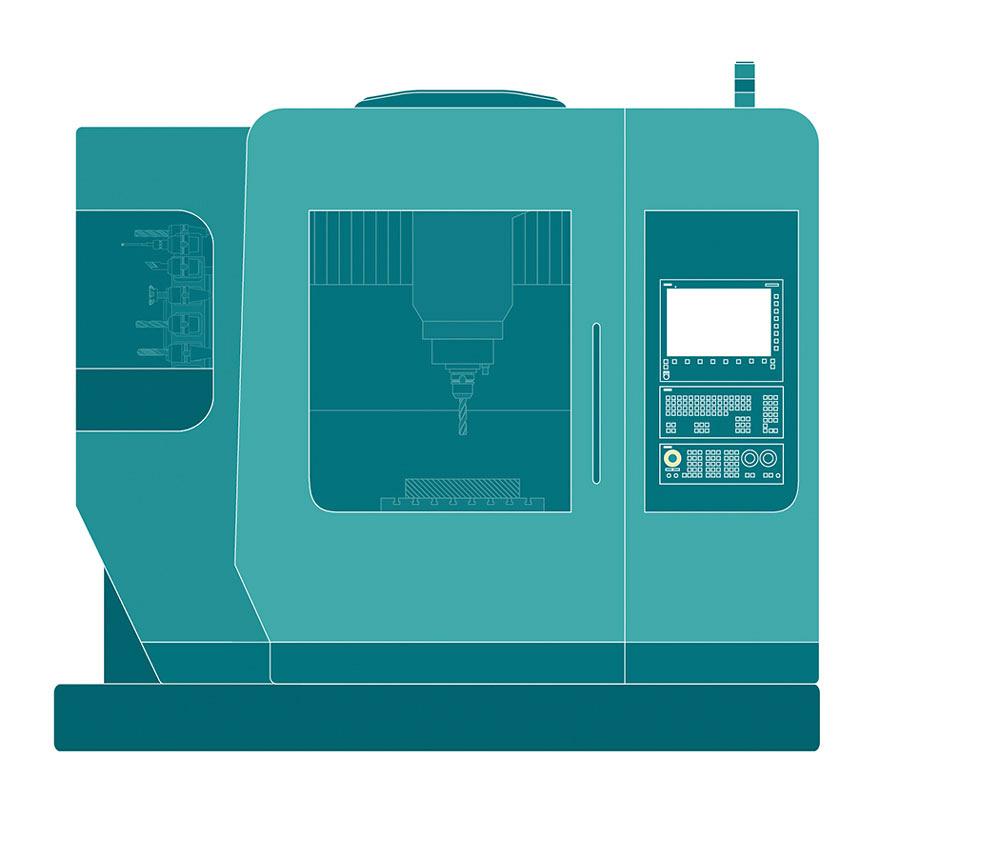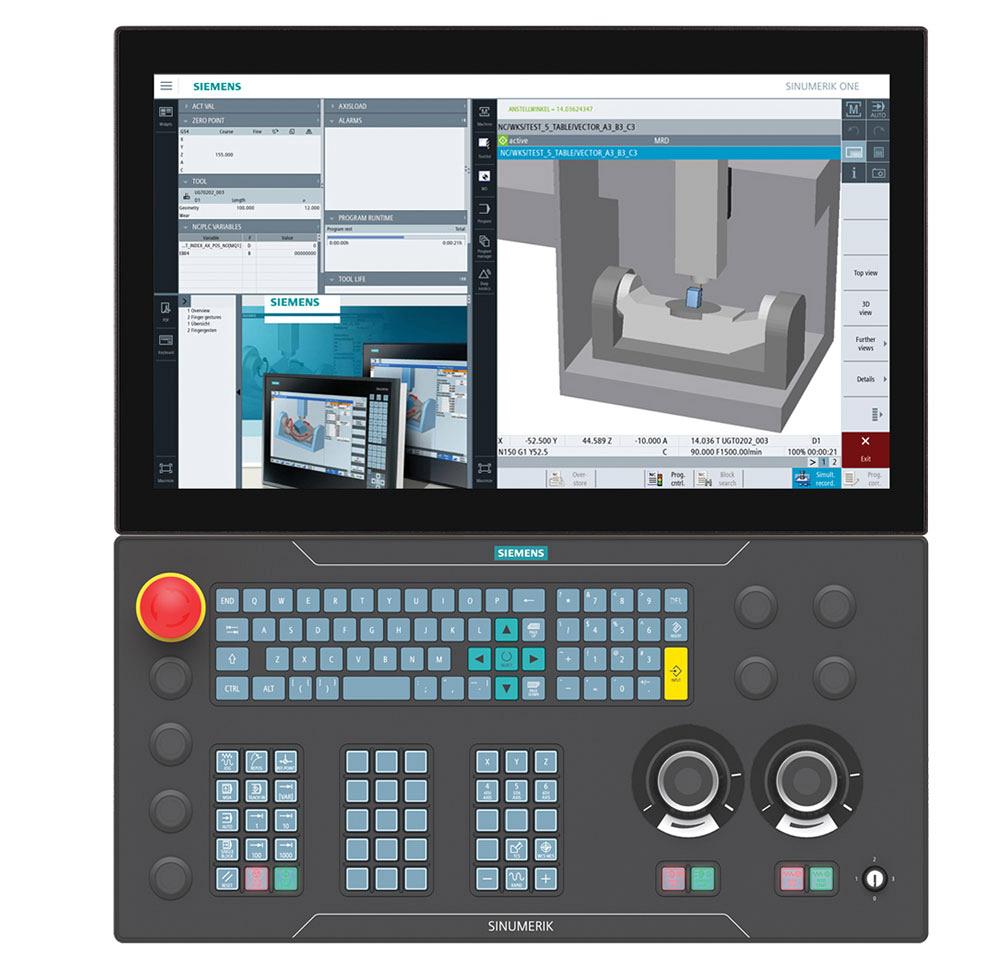Head of Machine Tool Business
- FMA
- The Fabricator
- FABTECH
- Canadian Metalworking
Technology Spotlight: Digital-native CNC
The path toward digitalization and the future of control technology
- By Brian McMinn
- September 29, 2022
- Article
- Metalworking

With the digital twin, every condition on the machine is simulated in real-time, with feedback to the design loop.
Big data, Industry 4.0, Internet of Things (IoT), edge technology, and the cloud are all terms we know. Whether you’re a job shop, contract manufacturer, or even a machine tool builder, you’re thinking about digitalization and the best way to get started.
For machinery builders, it’s about managing big data from the machine, reducing time-to-market, and using the newest technology to create smart machines. These are cognitive computing systems, meaning they can make decisions and solve problems without the help of a human. This is where artificial intelligence (AI) enters the equation, as the machine learns from what it does. In addition, machines must be ready to engage the IoT to be successful in the current market.
Machine builders still sell on the features and benefits of their machines, but this isn’t the only way to distinguish themselves from the competition.
The digital twin concept in machine development allows simulation of a machine tool not only in its design, but also in its physical performance, before the machine is even physically started.
With a digital twin, every condition on the machine is simulated in real time, with feedback to the design loop. That way, engineers don’t need to waste time on the shop floor or in a test centre as they’ve done previously with the trial-and-error method.
The science has developed, so must the build process.
Shop Size Doesn’t Matter
CNC machine users need their machines to be smart, as well — communicating with each other and the control centre in their shop or in a large production facility. Think you can’t implement digitalization because you’re a small machine shop? Think again.
Key performance indicators (KPIs) can be established and achieved sooner in terms of production, machine run time, maintenance, and even energy use.
For CNC users, the digital twin enables a machine shop to be IoT-ready. The higher-end software permits real-time, in-process adjustment, everything from cycle time to tool tip position or tool magazine loading for the next jobs, to facilitate both faster startup and precision workflow.
This can be achieved with a competent digital team that is both in tune with the current technology and knows how to implement it in a particular environment. If needed, you should take the time to find a system integrator in your area that can provide you with relevant technical and industry knowledge. This is vital to your success.

The Siemens SINUMERIK ONE CNC allows expansion, as job volumes increase, or the complexity of the work increases.
Our newest digital-native CNC, SINUMERIK ONE, for example, opens the next chapter in the machine tool world’s journey towards digitalization. It features the latest technology and software options to allow expansion as the job volume increases or the complexity of the work increases for you.
Going Virtual
Virtually, it offers the machine builder and end user total flexibility to move from CAD to CAM to the CNC machining steps, then onto the virtual shop floor and into a virtual production, all before the first cut is made on the machine.
As ransomware attacks become more common in the industrial environment, the issue of cybersecurity has taken on new importance.
Preventing any attack means taking several issues into consideration:
- The integrity of the network and the effects of the wireless network both in the plant and externally is important.
- How effective is your defence? Like a football game, one wrong move from a player can adversely impact the game plan.
- There must be several layers of specific security so that setup, operation and programming, maintenance, and plant operations/control personnel all have different defined levels of access to machines and data. This is often a time-consuming but very worthwhile endeavor.
If we look towards the future, what we see is digitalization at essentially every level of your factory. This includes robotic handling and the transfer of materials to the next machine.
The factory of the future isn’t empty of people, however. Rather, personnel take on higher-level tasks that don’t involve machining. Cobots and CNCs will work with a human or directly with the machine intelligently.
Digitalization is here to stay, so get started today.
Brian McMinn is the head of the Machine Tool Business at Siemens Industry, 847-952-4158, cnc.marketing.us@siemens.com.
About the Author

Related Companies
subscribe now


Keep up to date with the latest news, events, and technology for all things metal from our pair of monthly magazines written specifically for Canadian manufacturers!
Start Your Free Subscription- Trending Articles
Modest manufacturing growth appears likely

There’s no business like show business

Tighitco, DCM Group Aerospace join forces on Airbus A220 program

Software automatically identifies vulnerable production assets

NAIT names Sandvik Coromant the 2024 Distinguished Industry Partner

- Industry Events
MME Saskatoon
- May 28, 2024
- Saskatoon, SK Canada
CME's Health & Safety Symposium for Manufacturers
- May 29, 2024
- Mississauga, ON Canada
DiPaolo Machine Tools Open House 2024
- June 4 - 5, 2024
- Mississauga, ON Canada
FABTECH Canada
- June 11 - 13, 2024
- Toronto, ON Canada
Zoller Open House & Technology Days 2024
- June 12 - 13, 2024
- Ann Arbor, MI















